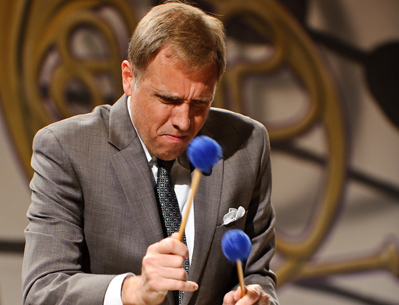Dec 9, 2025 12:28 PM
In Memoriam: Gordon Goodwin, 1954–2025
Gordon Goodwin, an award-winning saxophonist, pianist, bandleader, composer and arranger, died Dec. 8 in Los Angeles.…

Black Artists’ Group members Charles “Bobo” Shaw (left), Joseph Bowie, Floyd LeFlore, Baikida Carroll and Oliver Lake
(Photo: Courtesy of Oliver Lake)Bryan Dematteis’ new documentary, The Black Artists’ Group of St. Louis: Creation Equals Movement, debuted in November at the St. Louis International Film Festival and aims to increase awareness of the titular historical organization.
BAG—an interdisciplinary arts group formed in St. Louis in 1968 that staged concerts and multimedia performances blending music, drama and dance—served as a launching pad for the careers of jazz musicians like Oliver Lake, Baikida Carroll, Hamiet Bluiett, Julius Hemphill and Charles “Bobo” Shaw. During its four-year existence, BAG also showcased the talents of poet Shirley LeFlore, playwright Malinké Elliott and visual artist Oliver L. Jackson.
Dematteis became intrigued with BAG several years ago after reading an article that listed In Paris, Aries 1973 as one of the top-10 jazz experimental albums ever recorded. The recording was made by a quintet of BAG members: Lake (reeds, flute), Carroll (trumpet, flugelhorn), Shaw (drums), Floyd LaFlore (trumpet, vocals) and Joseph Bowie (trombone). All five members played percussion on the sessions.
“I’m from St. Louis, but at the time I wasn’t familiar with BAG,” Dematteis recalled during a phone conversation. “So, I started to dig, and when I did, I realized this was a much larger story than that one album.”
Building on his background in film and video, Dematteis founded the production company Foveal Media, which specializes in concert films, music videos and projects for nonprofits. His early interest in BAG was rekindled after reading Benjamin Looker’s 2004 book, “Point from Which Creation Begins”: The Black Artists’ Group of St. Louis (Missouri Historical Society Press).
“When I started Foveal, I decided to work on a documentary about BAG,” Dematteis explained. “I began in early 2014, when I filmed a two-hour interview with ‘Bobo’ Shaw. He put me in touch with George Sams, who was presenting concerts at his Metropolitan Gallery that featured BAG members like Shaw, Oliver Lake and Hamiet Bluiett. George was a great help in lining up interviews with Hamiet and other artists, and became a producer for the documentary.” (Bluiett died in 2018 at age 78.)
The process of filming interviews and locating film and photos from the BAG era was complicated by the fact that Dematteis had to finance the project himself.
“It took seven years before we could finally premiere it at the festival,” he said. “We were working with a volunteer crew and zero funding. But other organizations reached out to help. Jazz St. Louis found out about the BAG documentary and contacted me, asking how they could help. In 2016, they brought Oliver Lake to talk about BAG and perform at the Ferring Jazz Bistro. That’s how I was able to interview Oliver and Shirley LeFlore.”
During a telephone interview from his New Jersey home, Lake expressed his approval of the documentary, but also noted that both he and Dematteis regard the current, 49-minute version of the film as a work in progress.
“I really liked the film,” Lake said. “And I thought it captured what we tried to do at BAG—pulling people from different artistic backgrounds together to create something new that reflected the Black community in St. Louis. I told Bryan that I think there should be more music in the film performed by BAG musicians, so Baikida and I are putting together a list of possibilities to send to Bryan.”
“We’d been thinking of showing the film for the past couple years, and now we have it in a form [with which] we feel comfortable doing that,” Dematteis said. “And St. Louis was clearly the place to premiere it. ... It’s a film that will continue to evolve. Hopefully, as more people see it, that may open up access to more resources like photos and other BAG material that we can include.” DB

Goodwin was one of the most acclaimed, successful and influential jazz musicians of his generation.
Dec 9, 2025 12:28 PM
Gordon Goodwin, an award-winning saxophonist, pianist, bandleader, composer and arranger, died Dec. 8 in Los Angeles.…

Belá Fleck during an interview with Fredrika Whitfield on CNN.
Jan 13, 2026 2:09 PM
The fallout from the renaming of the John F. Kennedy Center for the Performing Arts to include President Donald…

Flea has returned to his first instrument — the trumpet — and assembled a dream band of jazz musicians to record a new album.
Dec 2, 2025 2:01 AM
After a nearly five-decade career as one of his generation’s defining rock bassists, Flea has returned to his first…

Dec 11, 2025 11:00 AM
DownBeat presents a complete list of the 4-, 4½- and 5-star albums from 2025 in one convenient package. It’s a great…

Vibraphonist Chuck Redd found himself in the midst of a political firestorm after canceling his gig Dec. 24 at the newly renamed Trump Kennedy Center.
Jan 6, 2026 2:32 AM
The Board of Trustees at Washington, D.C.’s Kennedy Center for the Performing Arts voted on Dec. 18 to rename the…